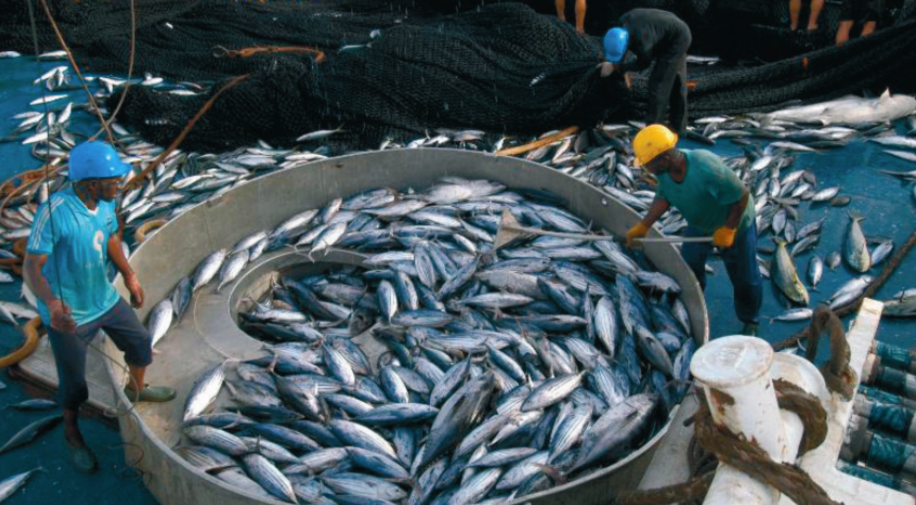
Tuna catches in the Seychelles fell by 40% last year. The cause: global warming. Between 2022 and 2023, catches fell from 113,566 tonnes to 69,000 tonnes. These figures were provided by the Minister of Fisheries and the Blue Economy, Jean-François Ferrari, to the National Assembly last Tuesday. Responding to a question from MP Waven William about the impact of El Niño, coral bleaching and overfishing on the sector’s various industries, he pointed out that climate change is a growing challenge for Small Island Developing States (SIDS) such as Seychelles. Jean-François Ferrari explained that rising ocean temperatures, exacerbated by extreme weather phenomena such as El Niño and La Niña, have considerably upset the ecological balance of marine environments. These phenomena, he pointed out, have led to major imbalances in the ecosystem. In addition to rising temperatures, marine currents have been greatly modified, as has the distribution of pelagic fish in the Indian Ocean.
SMALL-SCALE FISHERS HOLD STRONG!
Reflecting on the impact of the El Niño phenomenon, which was historically severe in 1998, it was highlighted that ocean warming forced purse seiners to search for fishing areas elsewhere. Last year, the effects of these climatic changes were felt once again, with a 10% drop in tuna catches in the Indian Ocean, decreasing from 403,000 tonnes to 373,000 tonnes. The impact of climate change on marine resources not only threatens the marine ecosystem but also affects fishers and those who depend on these resources. Jean-François Ferrari reminded that fishing is the second most important sector in the Seychelles economy. However, artisanal fishers are doing quite well. They have not only managed to maintain their fish catches over the past two decades but have actually increased them. This resilience is particularly evident in the use of traps, which have become increasingly effective as coral reefs, although degraded by bleaching, have transformed into environments dominated by microalgae. These habitats, dominated by microalgae, have proved advantageous for herbivorous fish, which are primarily targeted by artisanal fishing methods. Recent data confirms this positive trend, showing that artisanal fishing catches increased from about 2,500 tonnes in 2016 to 5,700 tonnes in 2023. This increase, noted Minister Ferrari, demonstrates the adaptability of traditional fishing practices in the face of environmental changes.
Meanwhile, a study published three months ago predicts heatwaves lasting 220 to 250 days by 2050 in the Indian Ocean. Titled Future Projections for the Tropical Indian Ocean, it emphasizes the consequences of an almost permanent marine heatwave, which directly endangers densely populated areas in countries such as India.
Marine Heatwaves
Marine heatwaves are periods during which ocean temperatures are abnormally high compared to the norm for a given season or region. These abnormally high temperatures must last at least five days to be considered a heatwave. Such near-permanent conditions lead to the intensification of cyclones and loss of income for fisheries and coastal communities. Between 1980 and 2020, 90% of cyclones in the Bay of Bengal and the Arabian Sea were preceded by marine heatwaves.
« In such conditions, cyclones go through a rapid intensification phase. They quickly escalate from Category 1 to Category 3 or 5, » explained Roxy Mathew Koll, a climatologist at the Indian Institute of Tropical Meteorology and the lead author of this study. Fishing is already prohibited during the monsoon season in India to protect fishermen from cyclones and heavy rainfall. However, since a near-permanent heatwave could prolong the monsoon season and further intensify cyclones, some fear that fishing may become entirely impractical.
« In theory, a fishing family can claim compensation of 10,000 INR (approximately 110 euros) for two months during the fishing ban. But many do not receive it. During cyclones, fishermen cannot go to sea again, and cyclones are becoming more frequent. How will fishing communities manage? » asked Debasis Paul.
Harmful Algae
Marine heatwaves also call into question the future viability of fishing in the Indian Ocean, as they cause migratory shifts in marine species and exacerbate the proliferation of harmful algae. The warming of ocean surface waters hinders the circulation of nutrients from cold, deep waters to the surface, leading to a reduction in the phytoplankton population, which is a critical food source for many marine species. Additionally, these heatwaves cause massive die-offs of species such as coral. When temperatures rise, corals expel the algae living in their tissues to reduce irritants, causing them to bleach—a process known as coral bleaching.
Extended bleaching, as during marine heat waves, leads to starvation in corals, which depend on algae for food. Coastal dwellers and marine species are not the only ones threatened by intensifying heat waves; warming of the Indian Ocean has been associated with more frequent droughts and heavy flooding across South Asia. It has also contributed to frequent droughts and locust invasions in East Africa, threatening food security in regions other than India.
Source: Clicanoo

